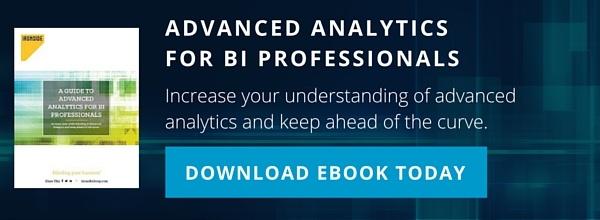Interview with Pam Askar, Ironside Data Scientist
How Data Scientists Find Order in Chaos
To help you understand Ironside’s philosophy on advanced analytics, data science, and predictive/prescriptive technologies, we thought it would be helpful to share insights directly from our data scientists.
This week I spoke with Pam Askar, who has over 10 years of quantitative research and predictive modeling experience and holds a PhD in Developmental Psychology from UConn. She worked in academia and the private sector as a psychology professor and a data modeler for a pharmaceutical market research firm before joining Ironside. This makes Pam uniquely qualified to both implement analysis strategies for clients and teach solutions in ways that ensure success. Regardless of the project, Pam’s deepest source of enjoyment is always the same: finding powerful solutions to complex problems that provide actionable business results.
Keen Hahn: Thanks for taking the time to talk with me today, Pam. To start off, what was it that inspired you to become a data scientist, and what’s the number one thing you think anyone new to advanced analytics should know about a data scientist’s role?
Pam Askar: I enjoy finding order in chaos. I suppose that’s how I see data mining, and it’s what got me interested in it in the first place. It’s a process of looking for signals in the noise that lead you to real results. In terms of the role, it requires one to be multifaceted. It not only demands statistics and programming skills, but business intelligence and communication skills as well.
KH: So taking into account all those skills you mention, what do you think a data scientist adds to an organization’s analytics capabilities?
PA: The data scientist makes the leap between simply being able to describe and understand your data to being able to monetize your data and turn it into action. Data scientists bring the ability to mine for patterns in data, predict outcomes, and prescribe actions. It’s the difference between knowing what you have and knowing what to do with it in order to be successful.
KH: That makes a lot of sense, but it also sounds like accomplishing all those value adds could get complicated. What’s the biggest challenge you’ve had as a data scientist when trying to provide those benefits, and what advice do you have for other people faced with similar challenges?
PA: Data preparation is the biggest part of any data science project. Accessing, storing, and preparing the vast amounts of data needed to get to usable results can be extremely challenging, but it’s necessary to figure out before the analysis even begins. If others are trying to address that challenge, I’d say the best thing to do would be to learn several programming languages and be able to at least discuss the new advances in data warehousing capabilities. This way you’ll know how the data is stored and how to get what you need from it.
KH: Sounds like it could be intimidating to account for all those factors. In fact, it seems like there’s a lot of fear in general around advanced analytics in the business world currently. How do you suggest we best conquer that fear?
PA: As someone who used to teach statistics to college students I can appreciate people’s fear of analytics. The thing to know though is that you don’t have to understand statistics to engage in a conversation about data science and what it could do for you. We, as the data scientists, have the skills to not only monetize your data but walk you through the process in a clear and easy to understand way. The first step is a conversation, not math class.
KH: It seems like some of the advanced analytics options in the marketplace are starting to head more in that conversational direction. How do you think these new tools make it easier for the average person to to include predictive and prescriptive analytics in their daily activities?
PA: New platforms, like Watson and to some extent SPSS Modeler, provide the non-data scientists of the world access to business analytics in new and exciting ways. With a little training they have the ability to explore and visualize data without having to learn a programming language or understand advanced statistics. These tools empower them and allow them to engage with the data directly, to understand it, and to form and test hypotheses. In fact, in the case of Watson, it can even become a conversation between the user and the tool since you can ask it potential analysis questions.
KH: Right, that seems like an incredibly useful feature. From my perspective, these new approaches appear to be opening the doors for what the industry is calling “citizen data scientists.” Thinking about that term, what do you think is the best way for someone to become a citizen data scientist and how can a citizen data scientist contribute to deeper analyses by professionals like you?
PA: In my mind, a citizen data scientist is an everyday person with a passion and mindset for data and analytics but perhaps not the training or education. With the right tools and targeted additional training, such an individual may reduce the demand on the data scientists by taking ownership of data exploration, visualization, and reporting. They could become a valuable contributor on a project by supplying hypotheses and testing relationships in the data. The best way to become a citizen data scientist is to raise your hand and let your organization know that you have these skills and interest and ask for additional training.
KH: So keeping in mind that with some specific training and guidance from a data scientist a good amount of the business user population can start contributing to advanced analytics efforts, what are the top three things you think everyone should do right now to start adding advanced analytics into their environments?
PA: Well, the first thing you need to do is take stock of what data you have available regardless of the form it’s in or how available it is. With that information top of mind, think through the biggest needs of your business right now. What are the gaps? Where are you struggling? What are the biggest threats to your business? Are they internal or external? Once you have an idea of where you stand, have a conversation with a data scientist. Explain to them your business needs and your list of available data. Ask them to create a list of use cases: potential ways that your data could work to help you. Form your own use cases as well. Stretch your mind a bit and think like a data scientist. What questions could your data answer and how could you put it to work for you? That will put you on track to real, actionable outcomes.
We hope you enjoyed hearing Pam’s perspective on data science and advanced analytics. To learn more about the topics discussed in this conversation, please get in touch. You can also check out our recent webinar on advanced analytics in higher education, Learn Techniques for Increasing Your Fundraising Efforts, or read interviews with Win Fuller and Chi Shu, our other Ironside data scientists. We look forward to helping you take the next step in your advanced analytics strategy.







